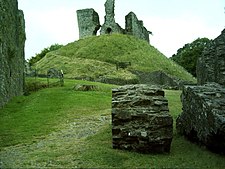Okehampton Castle
| Okehampton Castle | |
|---|---|
| Okehampton, Devon, England | |

Keep of Okehampton Castle
|
|
| Coordinates | 50°44′00″N 3°59′07″W / 50.7332°N 3.9852°WCoordinates: 50°44′00″N 3°59′07″W / 50.7332°N 3.9852°W |
| Grid reference | grid reference SX600945 |
| Type | Motte and bailey |
| Site information | |
| Owner | English Heritage |
| Open to the public |
Yes |
| Condition | Ruined |
| Site history | |
| Materials | Stone |
Okehampton Castle is a medieval motte and bailey castle in Devon, England. It was built between 1068 and 1086 by Baldwin FitzGilbert following a revolt in Devon against Norman rule, and formed the centre of the Honour of Okehampton, guarding a crossing point across the West Okement River. It continued in use as a fortification until the late 13th century, when its owners, the de Courtenays, became the Earls of Devon. With their new wealth, they redeveloped the castle as a luxurious hunting lodge, building a new deer park that stretched out south from the castle, and constructing fashionable lodgings that exploited the views across the landscape. The de Courtenays prospered and the castle was further expanded to accommodate their growing household.
The de Courtenays were heavily involved in the 15th century Wars of the Roses and Okehampton Castle was frequently confiscated. By the early 16h century the castle was still in good condition, but after Henry Courtenay was executed by Henry VIII the property was abandoned and left to decay, while the park was rented out by the Crown. Parts of the castle were reused as a bakery in the 17th century, but by the 19th century it was completely ruined and became popular with Picturesque painters, including J. M. W. Turner. Renovation work began properly in the 20th century, first under private ownership and then, more extensively, after the castle was acquired by the state. In the 21st century it is controlled by English Heritage and operated as a tourist attraction.
Okehampton Castle was built between 1068 and 1086 following the Norman conquest of England by Baldwin FitzGilbert.William the Conqueror defeated the Anglo-Saxon forces at the battle of Hastings in 1066, but violence continued to flare up periodically for several years after the invasion. Baldwin FitzGilbert, a Norman lord, was responsible for putting down a rebellion in Devon in 1068. He was probably given extensive lands in the county at this time, and by the time of Domesday Book in 1086 he was noted as the owner of the Honour of Okehampton and well as the Sheriff of Devon and Constable of Exeter Castle. The Honour of Okehampton was a grouping of around 200 estates across Devon, guarded by several castles, including Baldwin's main castle - or caput - at Okehampton, and those owned by his tenants, including Neroche and Montacute.
...
Wikipedia

